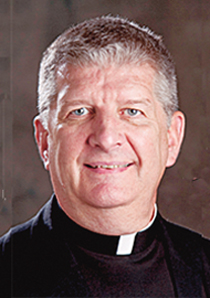
Faith
Just as the Order for the Christian Initiation of Adults makes new Christians through its rites -- baptism, confirmation, Eucharist -- so the dedication makes the building a church. The parallels are not accidental.

O’Grady
Churches have adjectives -- e.g., parish church, collegiate church, cathedral church. There are other designations for sacred spaces -- e.g., chapels, shrines, basilicas. Sometimes, the names or designations overlap, and sometimes several apply. But all are, in some way or manner, a holy place for a holy people. With the reminder that since here "we have no lasting home," as the Letter to the Hebrews tells us, the ultimate goal for God's holy people is to be in God's home.
A church building of any kind is made holy by some form of a blessing. The usual form is the Dedication of a Church and an Altar. The first edition of this book was issued in 1977, with an English translation following soon thereafter in 1979.
An updated translation was printed for use in the U.S. in 2018, and it is that volume to which we now turn in our liturgy library.
The actual title of the book is "The Order of the Dedication of a Church and an Altar." Its title is "Order" because it contains several different rites besides the preferred "Dedication of a Church and an Altar."
What's it all about?
In short, it's the Order of the Christian Initiation for a Building. Just as the Order for the Christian Initiation of Adults makes new Christians through its rites -- baptism, confirmation, Eucharist -- so the dedication makes the building a church. The parallels are not accidental. Nor are they in any way new. Once the church was able to worship in a public fashion, certainly by the fourth century, she has set aside places for that worship and made the buildings houses and home for God and his people.
Once the building is completed and ready to be used by the assembly, most often a parish, the date is set for the dedication. By right, the diocesan bishop is the principal celebrant; he could designate another bishop or even a priest, but that would happen in only the most unusual circumstances.
The assembly gathers in a place other than the new church. There, the building is "handed over" to the bishop -- symbolically by giving him the keys and the architectural plans. The bishop opens the doors of the church and leads the procession into it.
Once all have assembled inside the new church, the blessing and sprinkling of water start the ceremony. The prayer of blessing for the water has obvious echoes of the blessing for the water at the Easter Vigil and at baptisms. The bishop, assisted by two deacons, goes throughout the church, sprinkling first the people -- clergy, religious, and laity -- in the assembly, then the walls of the church, and lastly, the altar. The church has been "baptized," and all the assembled are reminded of their own baptism.
For the first time, God's Word is proclaimed with the bishop presenting the Lectionary to the first reader. This reading is always from the Old Testament Book of the prophet Nehemiah -- even during the Easter season when, by ancient custom, the Old Testament is not proclaimed.
Following the psalm response and the second reading and the Gospel, the bishop preaches the first homily in the new church.
The prayer of dedication and anointing begins with the Litany of Supplications, imploring all those who have already arrived in the heavenly Jerusalem to be with the pilgrim church as she makes her way in time and history towards the New Jerusalem.
If relics of the saints, especially of martyrs, are to be deposited below the altar (but not as in previous practice in the altar top) the bishop places them, and then the place for the relics is sealed.
Then, the wonderful prayer of dedication is either chanted or said by the bishop. This prayer emphasizes that the building is there to house the assembled people of God. It is stone and wood that comes to life through the lives of those who will worship in the church.
Next, the bishop anoints the altar with chrism. He will usually entrust the anointing of the walls to selected priests, preferably 12 but at least four. The places of the anointing are customarily marked by dedication candles. The new church has received its confirmation!
The bishop incenses the altar, putting the incense into a brazier placed on the altar. He then places incense in multiple thuribles; now designated priests proceed throughout the church, incensing the assembly and the building.
The altar is then vested in altar cloths, wax candles -- real, never artificial -- are placed around it and the area around the altar may be decorated with flowers -- real, never artificial. The candles are lighted, and the Mass continues with the most important part of the dedication -- the first celebration of the Eucharist. The church receives its First Communion.
The dismissal sends this holy assembly from its new holy house to be God's presence by word and deed in the world.
If you have the chance to be at the Dedication of a Church, go. It's a splendid celebration and a dramatic reminder of the truth that the Church is constructed above all by the living stones -- God's holy people.
Recent articles in the Faith & Family section
-
The Christmas crecheFather Robert M. O'Grady
-
Feeling like ChristmasJaymie Stuart Wolfe
-
Parish priests and their peopleMsgr. Frank Kelley
-
Be the carolArchbishop Richard G. Henning
-
Give a Christmas Gift to the MissionsMaureen Crowley Heil


















